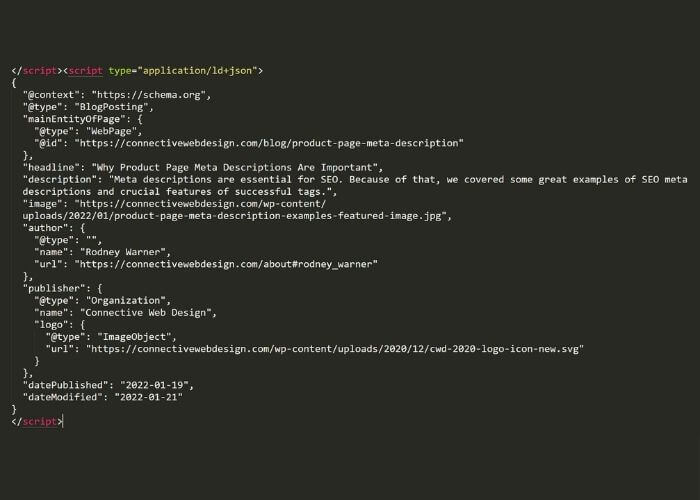Meta descriptions are a kind of HTML tag that summarizes the main content of the webpage. Search engines display meta descriptions under their results so you can get a quick snippet of the main thrust of the article.
Meta descriptions are essential for boosting search engine results. Compelling meta descriptions generate more clicks, which means more traffic to your site. Therefore, a key aspect of your SEO efforts should be optimizing meta descriptions.
Connective Web Designs understands the importance of concise and informative meta descriptions. Consequently, we put together this comprehensive guide on product page meta descriptions. We will cover some great examples of SEO meta descriptions as well as crucial features of successful tags.
The best product page meta descriptions for inspiration
SUPA NATURALS CBD – Describes the product

SUPA Naturals does a great job here with its concise, informative product page meta description. Each information point is relevant and answers some important questions about the product in question. SUPA Naturals also includes some structured data to show you customer ratings, price, and stock.
FRAGNATICA – Adding the male and female

Products containing male and female versions can benefit from separate meta descriptions. Including separate descriptions for male and female products makes your pages more precise and receptive to specific search intent.
HIBETT – Capitalizing the brand trademark

Brand trademarks are great for meta descriptions as they serve as attention grabbers and unique selling propositions. Hibett capitalizes its brand trademark in the meta description, thus immediately capturing your attention and making the listing unique. Brand trademarks can also display information about products.
CARGURU – Prioritizing how much a consumer can save with their product

Online shoppers are always seeking good deals on products and services. Carguru specializes in used and new car listings, so highlighting how much users can save by buying from their list is a great idea for a meta description. The Carguru meta description also denotes how many listings the site contains.
CRATE AND BARREL – Using urgency in the form of sale

Crate and Barrel is using an old psychological trick here to create a sense of urgency and stimulate customer action. By highlighting the sale, they are giving customers an incentive to buy more. Moreover, they warn that the sale is ending soon, creating customer urgency.
SHOPSTYLE – Highlighting variations

Clothing outlets that feature several versions of clothing work well with meta descriptions highlighting variations in product listings. Shopstyle has an extensive clothing catalog; emphasizing that fact serves as a unique selling point for their brand.
WALMART – Giving specifics right off the bat

One major problem is when meta descriptions are too vague and don’t provide critical information. Walmart does a good job here, giving exact specifics about their product right at the beginning. Sometimes, customers hesitate to visit the actual page to get product details.
BACKMARKET – Adding variations/emojis to stand out

Product page meta descriptions are typically text, but no rule says you can’t add other characters and formatting variations to stand out. Backmarket breaks up the flow of text with a handful of emojis, which immediately draw attention and establish the brand’s tone.
SWEETWATER – Intentionally cutting words at the end

Google meta descriptions have a 155-character limit, but that does not mean your descriptions have to be contained within that limit. In fact, intentionally cutting words can entice users to click on your link to view the remainder of the statement. Sweetwater does a good job building suspense about its services by cutting off the last few words of its meta tags.
AIRPORT PARKING SERVICE – Short and concise descriptions

When in doubt, simpler is better. This meta description nixes all the fluff and simply provides bullet points of the most critical information. When providing informational content about a product or service, sometimes it’s best to just stick with the facts.
What makes a great product page meta description?
Here are some features that make good product page meta descriptions, according to our expert marketing team.
Knowing search intent
When people use engines to search terms, they always have a reason. They might want to learn more about a product or make a purchase. They might also need more information.
Search intent is the reason why a person makes a particular search engine query. As a quick exercise, go through your recent search terms, asking yourself: “What was my intent when making those searches?”
Search intent is as vital for product meta descriptions as meta descriptions are to direct users to relevant content. The closer a meta description matches the search intent, the more likely it will receive higher rankings and traffic.
Think about your own internet searching habits. Which links are you more likely to click on—the ones containing a meta description with a quick summary of the info you desire? Or another entry? Getting good Google search rankings is primarily a matter of creating meta descriptions that match search intent.
Experts define four kinds of search intent:
- Informational. Most of the time, a person uses a search engine because they want to know something. Informational intent corresponds with search terms couched as questions—e.g., “When is Abraham Lincoln’s birthday?” or “How does cryptocurrency work?” Not all informational terms are in question form, however.
- Navigational. Users use navigational terms when they want to find a specific website without entering the actual URL. Queries such as “reddit login” or “Instagram homepage” map to navigational intent as the user is looking for something specific.
- Transactional. Transactional intent occurs when the user wants to purchase something. Terms like “buy Nikes online” or “iPhone 12 used” count for transactional intent as the goal is to buy.
- Commercial investigation. This intent shows up when users want to buy something but have not decided yet. They may be looking for comparisons and reviews between products and brands. Commercial searches include terms such as “Kajabi review” or “Coinbase vs Robinhood cryptocurrency.”
You can also infer search intent for keywords and phrases by looking at featured snippets on the SERP. Using SERP features can help you identify search intent for specific keywords and modifiers.
Pain points
If a customer is looking for a product, that means they have a problem that needs solving. Good meta descriptions should address these kinds of “pain points”—the kinds of concerns someone searching for your products might have. Ask yourself what kinds of problems and questions your customer might have, then modify meta descriptions accordingly.
For example, an electronics company selling a Bluetooth speaker may include a meta description like: “Compact and powerful Bose speaker system w/ Wi-Fi connectivity and smartphone compatibility.” The brief description addresses several questions someone looking for a Bluetooth speaker would likely have.
The most compelling product page meta descriptions succinctly and accurately summarize customers’ pain points and selling features. The better you understand your audience’s pain points, the more targeted you can make your product descriptions.
Unique selling proposition

Depending on the kinds of products you sell, you may have a lot of competition. How can you make your meta description stand out?
The answer is unique selling propositions. Customers want to know information about why they should choose one product over another. Selling propositions are unique features or services that differentiate your brand from others.
Your selling prepositions can be related to the product itself, but they can also be about some service related to the product. Terms like “free shipping,” “performance guarantee,” or “24/7 customer service” can entice customers to look at your results over others.
The main point of adding unique selling points is to help customers know what to expect when buying from you. The presentation of your selling propositions can heavily affect search engine rankings and engagement.
Attention grabber
Product page meta descriptions should offer more than a rote description of product features. They should appeal to the customer, grabbing their attention through some sensory description and lively copy.
For example, notice the difference between the following two descriptions, the second containing sharp, attention-grabbing content.
- “Our business software can help you manage accounts, invoice clients, and organize employee payroll. Contact today for a free sample!
- “Our business software suite can help take your company to the next level, with tools for organizing and managing accounts. Take the next step so your business can reach new heights!
Notice that the second meta description sounds much more earnest and livelier. Emotional language in meta descriptions is a great way to capture users’ attention and drive their traffic to your site. Other ways to grab attention include different typing formats, emojis, and other formatting templates.
For inspiration, look up search terms related to your products and see what kinds of meta descriptions appear first. Most likely, they will be full of informational content or spirited language emphasizing unique selling points and product feathers.
Using CTAs in a meta description
A CTA (call-to-action) is a kind of directive in marketing writing that tells the reader to perform a specific task. Common CTAs include prompts to buy products or subscribe to newsletters. In other words, a CTA is a snippet of text, usually near the end of a webpage, that tells the reader to complete some specific action, whether it’s clicking on an internal link or filling out a form.
Most businesses include some type of CTA on their main pages where they offer products and services. Blog posts will also typically include a CTA directing readers to other sections of the website or asking them to leave a comment. The exact kind of CTA you should use depends on the nature of the page it appears on.
CTAs may not seem like a big deal, but they matter a lot. A study from MECLABS found that including CTAs at the bottom of pages with some kind of value information increased conversions by nearly 220%. Moreover, nearly 70% of B2B businesses do not use CTAs in their promotional materials.
CTAs and product page meta descriptions go together like peanut butter and jelly. Phrases such as “click here” or “learn more” will compel readers to click on your links and bring you more traffic. CTAs can also tell users what they are most likely to find on a site.
Using structured data product page schema

Structured data refers to ecommerce programs that help search engines interpret meta description information to place in featured snippets. Product structured data schemas make it easier to translate product data into easy-to-read results.
With structured data, key product points and information will appear below meta descriptions on the search engine results page. Common fields for structured product data include price, customer reviews, product specs, and more. These kinds of snippets can significantly increase click-through rates by providing relevant information.
You can add structured data through page markups and decide exactly which information you want the algorithm to pull. You can create markups for singular product pages or your entire aggregate product page. Google also has tools allowing you to check for errors in the markup text and make sure the format appears as intended.
Here are some extra tips for improving your structured data product page schema.
- Make sure fields are properly nested so they display correctly in the meta description. Failing to format fields can cause them to list out of order, which may make your information hard to read.
- Consider which fields to include in your markups. For example, the Production Date field is useful if you change product models annually, and the Item Condition field is useful if you sell used and new goods. Avoid overloading descriptions with excessive fields that distract from the main meta description text.
- Use a JSON editor. JSON-LD is the recommended markup format and has the most flexible and straightforward implementation. Most search engines will also accept microdata and RDFa markup formats. Download a free JSON editor to check your code for validity.
Beyond meta descriptions
Product page meta descriptions are an important aspect of SEO, but they are not the full story. SEO best practices involve incorporating effective meta descriptions with other aspects.
Optimizing title tags
Title tags are important HTML elements that provide context for your web pages. Typically, the title tag is the very first contact a user has with your site. Effective title tags represent exactly what the page is about and how it is relevant to the search query.
You can add title tags directly into the HTML code or with your CMS markup editor. The optimal length for title tags is between 50 – 60 characters, though the search algorithm will count titles longer than 60 characters.
Search engines use title tags for three purposes.
- SERPs. Title tags determine what titles appear on the search engine results page. Your website may receive a good ranking, but a decent title can incentivize users to click your links.
- Web browser tabs. Modern browsers display title tags on different tabs, so users can organize their display when browsing multiple pages. Generally, the web browser tab is the same as your page title. Title tags should be highly unique so users can easily keep track of your pages while searching.
- Social media shares. Most social media pages, such as Facebook or Twitter, will show your title tag when someone shares your page. Most social media networks now have special HTML elements that let you change the appearance of the title depending on where the page appears.
Avoid overloading your titles with keywords. Google will dock your search results for excessive keywords in title tags, and it can interrupt user experience and turn them off your site. Google’s algorithm is constantly improving at detecting this kind of keyword stuffing, so it’s best to avoid unnecessary words in titles.
Good product page UX
They may not initially seem connected, but SEO and page user interface (UX) work together to provide a satisfactory experience for users. UX and SEO interact as the algorithm can take cures from your page layouts and navigations to display results.
For example, simple, well-organized navigation menus allow users to navigate your site easily and can improve search results. The algorithm can read site structure and provide links for pages in your index.
UX code can also affect search results. Search algorithms pull your website’s code to gather data. If you have rough, choppy code, your search engine results can suffer significantly. Clean code ensures the algorithm can read and properly interpret your data for search results pages.
Conclusions

Product page meta descriptions are an important but often forgotten aspect of ecommerce and SEO. Optimizing meta descriptions can significantly increase your online presence, traffic, and clickthrough rates. Strategic use of meta descriptions across all website pages is absolutely necessary to boost your search engine rankings.
Connected Web Designs focuses on data-driven marketing solutions for businesses in all niches. If you would like to schedule a consultation with our marketing team, contact us online.










